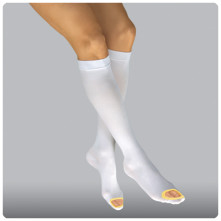Protect Yourself From Clots with Anti-Embolism Socks
After vein correction surgery, compression therapy is crucial! Anti-embolism socks provide several benefits. Primary among them is guarding against clots. Here’s how this hosiery optimizes cosmetic outcomes.
DVT Risk
Blood vessels are vulnerable to developing clots when their walls are cut and blood circulation slows or stops. Vein procedures render both these changes.
Additionally, after treatment, you’re temporarily less active than before. Decreased mobility slows blood flow. When circulation is sluggish, blood thickens, making it prone to clotting. This condition is termed “deep vein thrombosis,” abbreviated “DVT.”
The danger with a clot or “thrombus” is that part of it can break off and jam a blood vessel serving a vital organ. If the blockage occurs in your lungs, it can be fatal. A lodged thrombus is called an “embolism.”
Leg veins are at high risk for DVT. Their job of returning blood to the heart is challenged by distance and gravity. Both these factors promote blood pooling.
TED Hosiery
Anti-embolism stockings prevent DVT by improving circulation. Similar to tights, they’re made with elastic fabric, fitting snugly around your ankles and legs. The pressure they exert pushes blood upward, back toward your heart, preventing pooling and clotting.
This type of compression hosiery comes in knee-high and thigh-high lengths. Knee-highs are available in beige, black, and white. Thigh-length hose comes in white only.
Stocking pressure is measured in millimeters of mercury or “mmHg.” Anti-embolism socks are commonly called TEDs, standing for “Thromboembolic Deterrent.”
A TED stocking typically exerts 18 mmHg of pressure through its length. Procedures involving large veins may require more force. The sock area above the toes is open, for assessing circulation.
Research shows that compression hosiery effectively prevents DVT post-op. A review of 15 clinical trials found that the stockings can reduce clot risk by up to 63 percent.
Surgical Success
Dr. Tilara prescribes anti-embolism socks after spider and varicose vein procedures, such as sclerotherapy, endovenous ablation, and phlebectomy. Each of these treatments is performed in-office, without requiring hospitalization.
Sclerotherapy
For this procedure, Dr. Tilara injects medicine into a bulging vein. The chemical irritates its walls, after which they collapse and fuse. Gradually, the vein fades from view.
Immediately after sclerotherapy, you must guard against clots by wearing TEDs. Without compression, blood can return to a partially collapsed vein and form a thrombus.
Sock pressure also encourages treated veins to seal and reduces post-op swelling. Additionally, TEDs prevent pigmentation, yielding a better cosmetic appearance.
After sclerotherapy, Dr. Tilara advises walking daily and wearing TEDs for up to three weeks.
Endovenous Ablation
This treatment uses laser energy to heat and close a varicose vein. Subsequently, the vessel shrinks and disappears. This procedure uses ultrasound guidance for precise vein visualization.
Wearing TEDs after endovenous ablation facilitates vein shrinkage and prevents thrombus formation. Compression also reduces post-op tenderness, swelling, and bruising.
For the first week after the procedure, Dr. Tilara advises walking five minutes each hour. The doctor will specify how long anti-embolism socks should be worn.
Phlebectomy
For this method, Dr. Tilara uses tiny incisions and a surgical hook to remove medium and large varicose veins. Since the cuts are so small, less than 1/4 inch long, the procedure is also called “microphlebectomy.” Incisions are closed with adhesive strips, without the need for stitches.
Microphlebectomy is the modern alternative to vein stripping, a surgical procedure requiring hospitalization and general anesthesia. Since microphlebectomy slits are superficial, only local numbing is necessary. Immediately after the procedure, you can walk and drive. Walking expedites healing and prevents DVT.
Wearing TEDs after microphlebectomy minimizes bruising and swelling. Compression also prevents blood from being trapped in remaining vein segments. Dr. Tilara advises how long to wear TEDs, depending on the size of excised veins.
Stocking Application
Knee-high stockings fit either leg. Seams should be on the outside of the hose, the smooth sides against your skin.
To apply a knee-high, place your hand inside the foot section, grasp the heel, and pull the stocking inside out. Do not roll the hose into a donut.
Place the sock over your foot and heel, making sure the heel is centered in the pocket. Holding the fabric securely, work the sock over your ankle and up your calf and leg. The top cuff should rest two finger-widths below the bottom of your kneecap.
Smooth out any wrinkles along the stocking length. Then, pull the toe section forward, to smooth the ankle and sole. Note that bunching and wrinkling impair uniform sock pressure.
Apply thigh-high stockings similarly, to knee level, referring to this graphic. The stitch change in the fabric should fall two finger-widths below the bend of your knee. When you get to the thigh section, turn the stocking so the U-shaped stitching is positioned at your inner thigh. The top cuff should rest at the crease below your buttocks. Smooth out the fabric, and pull the toe section forward.
Stocking Care
Be sure to launder your hose every three days. Washing extends wear length by removing skin oils and perspiration, which weaken elastic.
Wash your stockings in cold water, either by hand or machine. Do not use chlorine bleach. For machine washing, use a delicate cycle, protecting the TEDs inside a zippered, netted bag. Air-dry the socks on a hanger.
Your Safety
Dr. Amish Tilara is a board-certified vascular and interventional radiologist, expert in vein correction procedures. An attentive listener, Dr. Tilara is patient and thorough in his explanations. His kind and caring demeanor will surely put you at ease. Here’s a sampling of grateful comments by his patients.
Appointments
Atlanta Vascular and Vein Center, located in Lawrenceville, Georgia, serves residents in northeast Atlanta, including Dacula, Grayson, Snellville, Lilburn, Norcross, Duluth, Suwanee, and Buford. For an appointment, please call (678) 878-4555. You can also email us here.
Dr. Tilara’s priority is your comfort, safety, and surgical success. Therefore, you can trust his instructions regarding compression therapy. For optimal treatment outcomes, follow his skilled advice!
Note – The information provided here cannot substitute for professional medical care. For any vascular concerns, contact Dr. Amish Tilara at Atlanta Vascular and Vein Center.
Photo credit for anti-embolism stockings
© 2018 Atlanta Vascular & Vein Center. All rights reserved.








